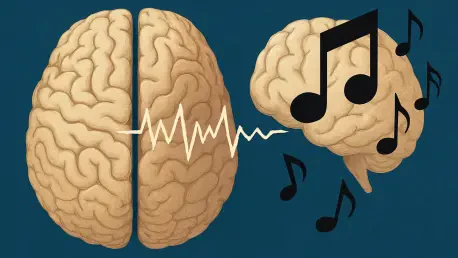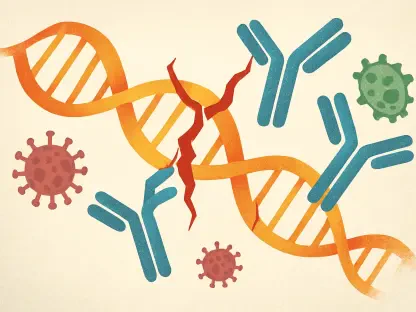Imagine a world where the soaring notes of a symphony or the infectious beat of a pop song evoke nothing—no joy, no emotion, just silence in the soul despite perfect hearing. This is the reality for individuals with specific musical anhedonia, a rare condition where music fails to trigger pleasure, affecting only a small fraction of the population and captivating neuroscientists as a key to unlocking the brain’s intricate reward systems. This roundup gathers insights from various experts and studies to dissect the neurological roots, measurement tools, and broader implications of musical anhedonia, aiming to shed light on why some minds remain unmoved by melodies and what this reveals about human emotion.
Neurological Underpinnings: Why Music Falls Flat
Diving into the brain’s wiring, multiple neuroscience teams have pinpointed a critical disconnect in individuals with musical anhedonia. Studies using functional magnetic resonance imaging (fMRI) consistently show reduced activity between the auditory cortex, responsible for processing sound, and reward centers like the nucleus accumbens. This gap means that while the brain registers music, it fails to translate the experience into a rewarding sensation, unlike other stimuli such as financial gains, which activate these pathways normally.
Contrasting opinions emerge on the nature of this disconnect. Some researchers argue it stems from structural differences in neural pathways, suggesting an inherent wiring issue. Others propose that unrecognized factors, possibly tied to past experiences or subtle developmental changes, might contribute to this separation. This debate fuels ongoing investigations into whether the condition is fixed or potentially malleable through targeted interventions.
A third perspective highlights the specificity of this neural quirk. Unlike general reward deficits seen in conditions like depression, musical anhedonia isolates music as the sole unpleasurable stimulus for many affected individuals. This selectivity challenges traditional models of uniform reward processing and pushes the scientific community to rethink how the brain assigns value to different experiences.
Tools and Techniques: Measuring the Absence of Joy
One of the standout methods for studying this condition is a specialized questionnaire designed to assess musical enjoyment across multiple dimensions, such as emotional resonance, social connection, and mood regulation. Research groups report that individuals with musical anhedonia score notably low across all these facets, confirming a pervasive lack of pleasure rather than a dislike for specific genres or styles.
Different schools of thought exist on the application of such tools. Certain experts advocate for their use as a diagnostic benchmark, arguing they provide a reliable way to identify affected individuals across diverse populations. However, others caution against over-reliance, pointing out the challenge of distinguishing true neurological anhedonia from cultural disinterest or lack of exposure to music, which could skew results.
Beyond identification, there’s discussion on adapting these assessment frameworks to other domains. Some neuroscientists suggest that similar tools could be developed to explore specific anhedonias related to food or visual art, potentially revealing parallel disconnects in sensory-reward integration. This cross-disciplinary potential excites many in the field, though skepticism remains about generalizing findings without extensive validation.
Genetic and Environmental Influences: Nature or Nurture?
The origins of musical anhedonia spark lively discourse among geneticists and behavioral scientists. Twin studies cited by various research collectives indicate that up to 54% of musical enjoyment may be tied to genetic factors, pointing to a significant hereditary component. This suggests that some individuals might be predisposed to this condition from birth due to inherited neural configurations.
On the flip side, environmental influences garner equal attention. Experts in cultural neuroscience emphasize that upbringing, exposure to music, and personal history shape how the brain responds to auditory stimuli. For instance, growing up in a setting where music plays a minimal role might dull emotional connections to it, though this alone doesn’t equate to anhedonia in the clinical sense.
A balanced view gaining traction combines these elements, proposing that genetic predisposition interacts with life experiences to determine musical reward processing. Some researchers speculate that from the current year onward, studies spanning 2025 to 2027 could clarify this interplay through longitudinal data, offering hope for identifying whether environmental shifts might alter neural responses over time.
Broader Implications: Rethinking Reward Systems
Musical anhedonia’s impact extends far beyond music itself, prompting a reevaluation of how reward systems operate. Many neuroscientists argue that the condition reveals a stimulus-specific framework for pleasure, contradicting older views of reward as a monolithic function. This insight suggests that the brain evaluates different joys—be it music, food, or social bonds—through distinct neural interactions.
Comparative analyses with other anhedonias, including those linked to depression or specific stimuli like taste, are a focal point for some experts. They propose that understanding these variations could inspire tailored mental health interventions, addressing specific deficits rather than broad reward dysfunction. This personalized approach is seen as a promising frontier in clinical neuroscience.
Speculation also arises about therapeutic possibilities. A segment of the research community explores whether neuroplasticity-based strategies, such as targeted training or stimulation, could strengthen auditory-reward connections. While opinions differ on feasibility, the potential to restore musical pleasure adds a compelling layer to discussions about brain adaptability and recovery.
Wrapping Up the Insights
Reflecting on this roundup, the exploration of musical anhedonia uncovered a wealth of perspectives that deepened the understanding of this unique condition. Neurologists and geneticists provided critical insights into the brain’s disconnects and hereditary influences, while cultural researchers highlighted the role of environment in shaping responses. The debates over measurement tools and therapeutic prospects underscored the complexity of reward processing, painting a picture of a field ripe with questions and possibilities. Moving forward, readers might consider diving into related neuroscience literature or supporting studies that map individual differences in emotion. Exploring personal connections to music and other stimuli could also offer a practical lens to appreciate the diversity of human experience revealed through such research.









